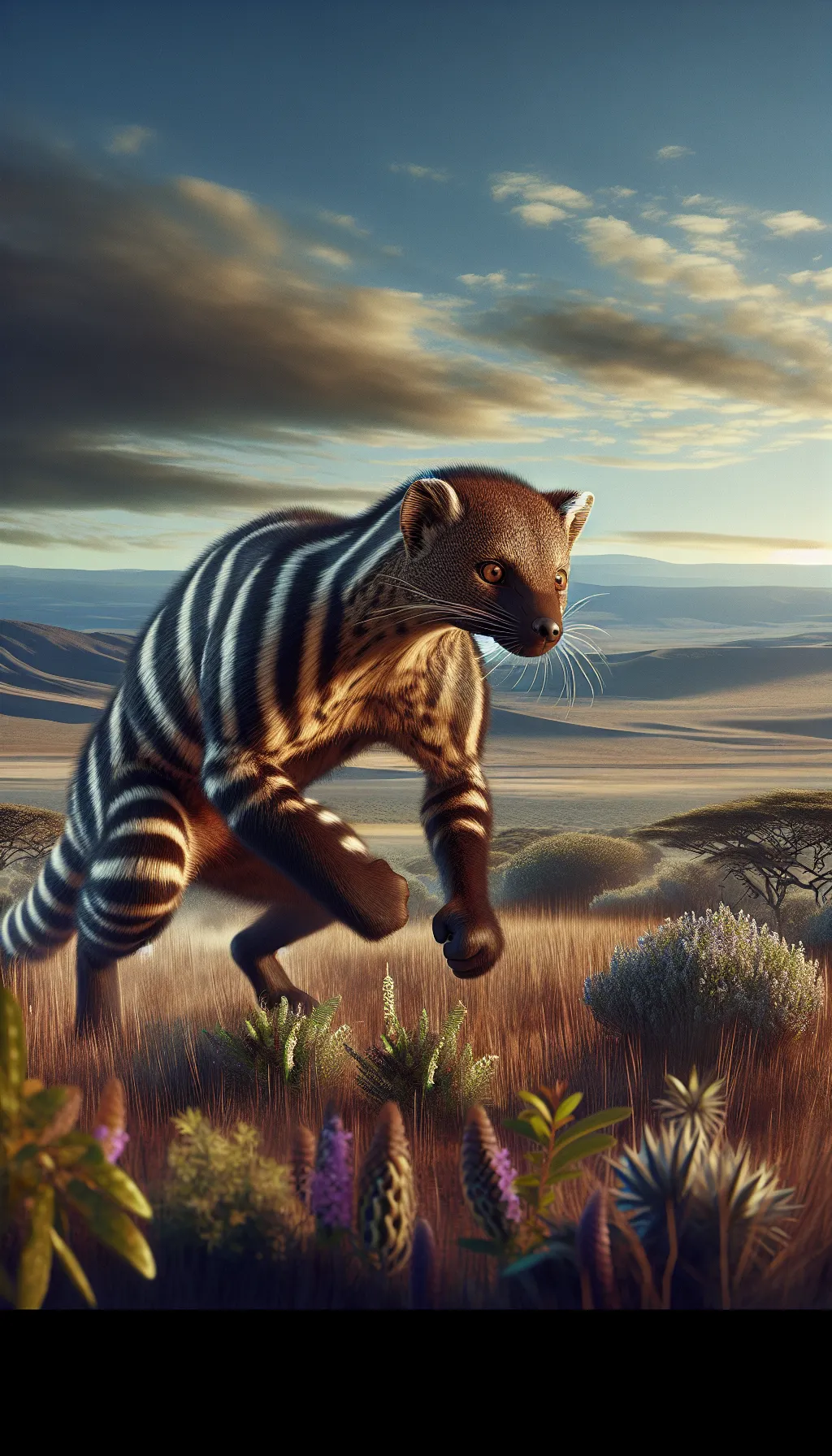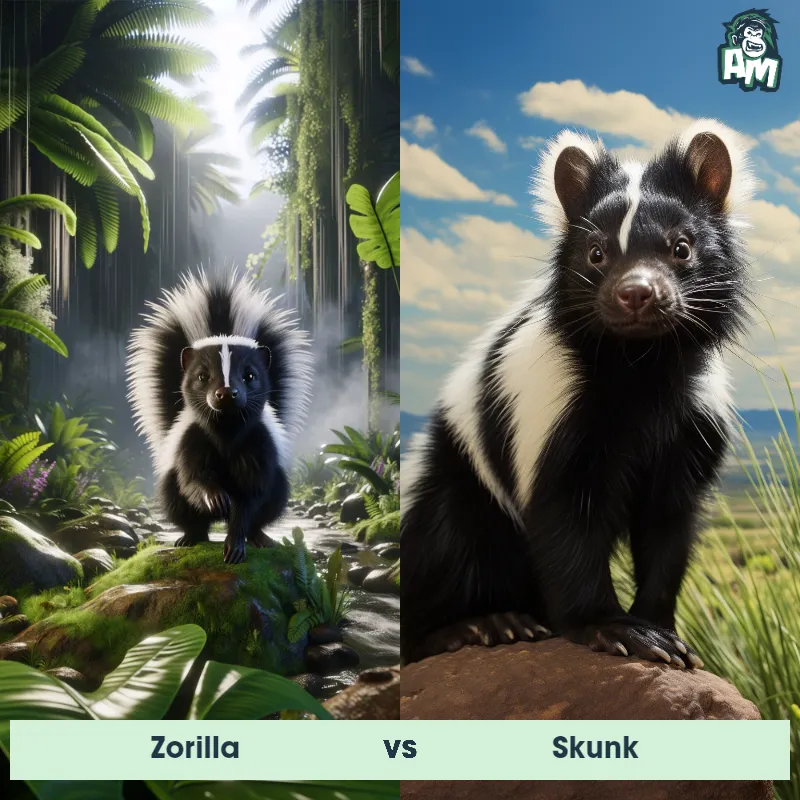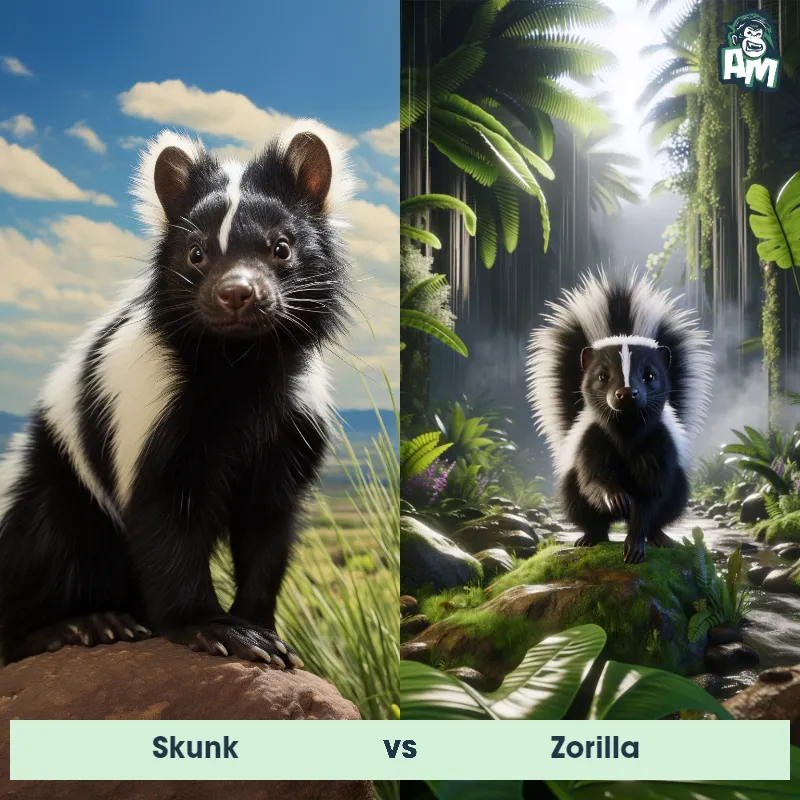The Zorilla
The Zorilla, commonly known as the Striped Polecat, is a small carnivorous mammal native to Africa. With a body length of about 35 to 50 centimeters and a weight of around 1 to 2 kilograms, it has a slender build and short legs. The Zorilla is highly recognizable due to its unique black and white striped fur pattern, which serves as a warning to predators. It also possesses a strong musky odor that it emits as a defense mechanism. This nocturnal animal is known for its agility and ability to dig burrows, where it spends its days resting.

| Zorilla | |
|---|---|
| Size | 40-45 cm (15.7-17.7 inches) in length |
| Weight | 1-3.3 kg (2.2-7.3 lbs) |
| Speed | 26mph (42km/h) |
| Key Strength | Agility and speed |
| Biggest Weakness | Lack of physical strength |
| Scientific Name | Ictonyx striatus |
| Family | Mustelidae |
| Habitat | Grasslands, savannas, and open woodlands |
| Geography | Central and southern Africa |
| Diet | Insects, small mammals, reptiles, birds, and eggs |
| Lifespan | 3 years - 5 years |

The Zorilla
The Zorilla, commonly known as the Striped Polecat, is a small carnivorous mammal native to Africa. With a body length of about 35 to 50 centimeters and a weight of around 1 to 2 kilograms, it has a slender build and short legs. The Zorilla is highly recognizable due to its unique black and white striped fur pattern, which serves as a warning to predators. It also possesses a strong musky odor that it emits as a defense mechanism. This nocturnal animal is known for its agility and ability to dig burrows, where it spends its days resting.
Fun Fact: The Zorilla has quite an interesting protective strategy when it feels threatened – it will put on a remarkable display of "stotting." This behavior involves the Zorilla jumping in the air with its arched back and tail raised high, effectively showcasing its bold warning colors and emitting its strong scent, all to intimidate potential predators.
| Zorilla | |
|---|---|
| Size | 40-45 cm (15.7-17.7 inches) in length |
| Weight | 1-3.3 kg (2.2-7.3 lbs) |
| Speed | 26mph (42km/h) |
| Key Strength | Agility and speed |
| Biggest Weakness | Lack of physical strength |
| Scientific Name | Ictonyx striatus |
| Family | Mustelidae |
| Habitat | Grasslands, savannas, and open woodlands |
| Geography | Central and southern Africa |
| Diet | Insects, small mammals, reptiles, birds, and eggs |
| Lifespan | 3 years - 5 years |
Zorilla Matchups
We use AI to simulate matchups between the Zorilla and other animals. Our simulation considers size, strength, and natural predatory behaviors to determine the most likely outcome.
Zorilla: Diet, Predators, Aggression, and Defensive Behaviors
What do Zorillas eat?
Zorillas are mainly carnivorous animals and their diet consists of insects, small rodents, birds, eggs, and sometimes fruits. They are skilled hunters and use their strong sense of smell to locate prey.
Do Zorillas have any predators?
Yes, Zorillas have several predators in the wild including large birds of prey, such as eagles and owls, as well as larger carnivores like jackals, hyenas, and big cats. They are also at risk from humans who sometimes view them as pests.
Are Zorillas aggressive?
Zorillas are not typically aggressive animals and they will usually only become defensive when threatened. However, they can exhibit aggressive behavior if they feel cornered or scared. They may try to scare off predators by raising their tail and releasing a foul-smelling odor.
Do Zorillas fight?
Zorillas are known to engage in confrontations with other animals, especially when competing for food or territory. They may engage in physical fights with rivals of the same species but these encounters are usually brief and end quickly.
How do Zorillas defend themselves?
Zorillas have a unique defense mechanism where they can release a strong-smelling liquid from their anal glands as a deterrent against predators. This foul-smelling spray can be sprayed at a target up to several feet away. They also have sharp claws and teeth which they can use to defend themselves if necessary.
What is the Zorilla's biggest weakness in a fight?
Despite their ability to release a smelly spray to ward off predators, Zorillas also have a few weaknesses in a fight. They are relatively small in size compared to some of their predators, making them vulnerable to being overpowered. Additionally, their defensive spray can sometimes be ineffective against certain predators, especially those with a strong sense of smell.
Fun Fact: Despite its name, the Zorilla is not a true member of the skunk family. However, it shares many similarities with skunks, including its striped markings and ability to spray a noxious fluid from anal scent glands when feeling threatened. This liquid can cause temporary blindness and intense irritation to potential attackers, acting as an effective deterrent.
Fun Fact: The Zorilla is a skilled hunter, feeding primarily on small rodents, insects, and the occasional bird. It has an impressive ability to locate prey through its exceptional sense of smell and hearing, aided by its keen eyesight. In addition to its carnivorous diet, the Zorilla also supplements its food intake with plant material, such as fruits and berries, making it an omnivorous species.













